Flood Inundation and Depth Mapping Using Unmanned Aerial Vehicles Combined with High-Resolution Multispectral Imagery
Abstract
1. Introduction
2. Materials and Methods
2.1. Study Area
2.2. UAV Platform and Sensors
2.3. Flooding Event and Aerial Data Collection
2.4. Ground Truthing Data
2.5. Data Processing
- The RGB and OCN image datasets were acquired using a UAV platform on a gridded automated flight plan;
- GCPs were collected as Trimble survey points with an accuracy of ±1 cm horizontal and ±3 cm vertical;
- PPK processing was performed to provide RGB images with geotagged locations with an accuracy of ±5 cm;
- OCN images were preprocessed to provide reflectance calibration;
- RGB images were imported into Pix4DMapper, together with the information about acquisition locations (coordinates), including the roll, pitch, and yaw of the UAV platform. The information was used for the preliminary image orientation;
- “Matching” in Pix4D comprised three steps: First, a feature-detection algorithm was applied to detect features (or “key points”) on every image. The number of detected key points depends on the image resolution, image texture, and illumination. Second, matching key points were identified, and inconsistent matches were removed. Third, a bundle-adjustment algorithm was used to simultaneously solve the 3D geometry of the scene, the different camera positions, and the camera parameters (focal length, coordinates of the principal point and radial lens distortions). The output of this step was a sparse point cloud.
- The GCP coordinates were imported and manually identified on the images. The GCP coordinates were used to refine the camera calibration parameters and to re-optimize the geometry of the sparse point cloud.
- Multi-view stereo image-matching algorithms were applied to increase the density of the sparse point cloud into a dense point cloud.
- A digital surface model (DSM), which consists of a textured map, was derived from all images and applied to the polygon mesh that was used to create an orthomosaic.
- The DSM and orthomosaics for RGB and OCN were exported from Pix4DMapper into ArcGIS Pro.
- A digital elevation model (DEM) generated from the RGB point cloud and exported from Pix4DMapper into ArcGIS Pro. Alternatively, a DEM can be generated using LiDAR data for faster results. Both UAV-DEM-derived and LiDAR-derived results are explored in the following sections and are referred to as the full-integration (FI) mode and partial-integration (PI) mode, respectively.
- RGB, OCN, and DEM were combined into a single raster file in ArcGIS Pro for analysis.
2.5.1. Model Data
2.5.2. Water Surface Extent Algorithm
2.5.3. Water Depth Algorithm
2.6. Model Output
3. Validation and Results
3.1. Inundation Validation
3.2. Depth Validation
3.3. Land Type Classification
4. Discussion
4.1. Full versus Partial Model Discussion
4.2. Land-Type Classification Discussion
4.3. Depth Results Discussion
4.4. Other DEM-Derived Floodwater Depth Mapping Methods
5. Conclusions
Author Contributions
Funding
Data Availability Statement
Acknowledgments
Conflicts of Interest
References
- Li, Z.; Gao, S.; Chen, M.; Gourley, J.J.; Hong, Y. Spatiotemporal Characteristics of US Floods: Current Status and Forecast under a Future Warmer Climate. Earths Future 2022, 10, e2022EF002700. [Google Scholar] [CrossRef]
- Tabari, H. Climate Change Impact on Flood and Extreme Precipitation Increases with Water Availability. Sci. Rep. 2020, 10, 13768. [Google Scholar] [CrossRef]
- Hirabayashi, Y.; Mahendran, R.; Koirala, S.; Konoshima, L.; Yamazaki, D.; Watanabe, S.; Kim, H.; Kanae, S. Global Flood Risk under Climate Change. Nat. Clim. Chang. 2013, 3, 816–821. [Google Scholar] [CrossRef]
- Kirezci, E.; Young, I.R.; Ranasinghe, R.; Muis, S.; Nicholls, R.J.; Lincke, D.; Hinkel, J. Projections of Global-Scale Extreme Sea Levels and Resulting Episodic Coastal Flooding over the 21st Century. Sci. Rep. 2020, 10, 11629. [Google Scholar] [CrossRef]
- Floods|World Meteorological Organization. Available online: https://public.wmo.int/en/our-mandate/water/floods (accessed on 15 June 2023).
- Chetpattananondh, K.; Tapoanoi, T.; Phukpattaranont, P.; Jindapetch, N. A Self-Calibration Water Level Measurement Using an Interdigital Capacitive Sensor. Sens. Actuators Phys. 2014, 209, 175–182. [Google Scholar] [CrossRef]
- Marin-Perez, R.; García-Pintado, J.; Gómez, A.S. A Real-Time Measurement System for Long-Life Flood Monitoring and Warning Applications. Sensors 2012, 12, 4213–4236. [Google Scholar] [CrossRef] [PubMed]
- De Camargo, E.T.; Spanhol, F.A.; Slongo, J.S.; Da Silva, M.V.R.; Pazinato, J.; De Lima Lobo, A.V.; Coutinho, F.R.; Pfrimer, F.W.D.; Lindino, C.A.; Oyamada, M.S.; et al. Low-Cost Water Quality Sensors for IoT: A Systematic Review. Sensors 2023, 23, 4424. [Google Scholar] [CrossRef]
- Tien, I.; Lozano, J.-M.; Chavan, A. Locating Real-Time Water Level Sensors in Coastal Communities to Assess Flood Risk by Optimizing across Multiple Objectives. Commun. Earth Environ. 2023, 4, 96. [Google Scholar] [CrossRef]
- Zheng, G.; Zong, H.; Zhuan, X.; Wang, L. High-Accuracy Surface-Perceiving Water Level Gauge with Self-Calibration for Hydrography. IEEE Sens. J. 2010, 10, 1893–1900. [Google Scholar] [CrossRef]
- Chaudhary, P.; D’Aronco, S.; Moy De Vitry, M.; Leitão, J.P.; Wegner, J.D. Flood-water level estimation from social media images. ISPRS Ann. Photogramm. Remote Sens. Spat. Inf. Sci. 2019, IV-2/W5, 5–12. [Google Scholar] [CrossRef]
- Moy De Vitry, M.; Kramer, S.; Wegner, J.D.; Leitão, J.P. Scalable Flood Level Trend Monitoring with Surveillance Cameras Using a Deep Convolutional Neural Network. Hydrol. Earth Syst. Sci. 2019, 23, 4621–4634. [Google Scholar] [CrossRef]
- Schumann, G.; Bates, P.D.; Horritt, M.S.; Matgen, P.; Pappenberger, F. Progress in Integration of Remote Sensing–Derived Flood Extent and Stage Data and Hydraulic Models. Rev. Geophys. 2009, 47, RG4001. [Google Scholar] [CrossRef]
- Dimitriadis, P.; Tegos, A.; Oikonomou, A.; Pagana, V.; Koukouvinos, A.; Mamassis, N.; Koutsoyiannis, D.; Efstratiadis, A. Comparative Evaluation of 1D and Quasi-2D Hydraulic Models Based on Benchmark and Real-World Applications for Uncertainty Assessment in Flood Mapping. J. Hydrol. 2016, 534, 478–492. [Google Scholar] [CrossRef]
- Hosseiny, H.; Nazari, F.; Smith, V.; Nataraj, C. A Framework for Modeling Flood Depth Using a Hybrid of Hydraulics and Machine Learning. Sci. Rep. 2020, 10, 8222. [Google Scholar] [CrossRef]
- Li, W.; Li, D.; Fang, Z.N. Intercomparison of Automated Near-Real-Time Flood Mapping Algorithms Using Satellite Data and DEM-Based Methods: A Case Study of 2022 Madagascar Flood. Hydrology 2023, 10, 17. [Google Scholar] [CrossRef]
- Tarpanelli, A.; Mondini, A.C.; Camici, S. Effectiveness of Sentinel-1 and Sentinel-2 for Flood Detection Assessment in Europe. Nat. Hazards Earth Syst. Sci. 2022, 22, 2473–2489. [Google Scholar] [CrossRef]
- Peng, B.; Huang, Q.; Vongkusolkit, J.; Gao, S.; Wright, D.B.; Fang, Z.N.; Qiang, Y. Urban Flood Mapping with Bitemporal Multispectral Imagery Via a Self-Supervised Learning Framework. IEEE J. Sel. Top. Appl. Earth Obs. Remote Sens. 2021, 14, 2001–2016. [Google Scholar] [CrossRef]
- Psomiadis, E.; Diakakis, M.; Soulis, K.X. Combining SAR and Optical Earth Observation with Hydraulic Simulation for Flood Mapping and Impact Assessment. Remote Sens. 2020, 12, 3980. [Google Scholar] [CrossRef]
- Schumann, G.J.-P.; Neal, J.C.; Mason, D.C.; Bates, P.D. The Accuracy of Sequential Aerial Photography and SAR Data for Observing Urban Flood Dynamics, a Case Study of the UK Summer 2007 Floods. Remote Sens. Environ. 2011, 115, 2536–2546. [Google Scholar] [CrossRef]
- Heimhuber, V.; Tulbure, M.G.; Broich, M. Addressing Spatio-Temporal Resolution Constraints in Landsat and MODIS-Based Mapping of Large-Scale Floodplain Inundation Dynamics. Remote Sens. Environ. 2018, 211, 307–320. [Google Scholar] [CrossRef]
- Wu, T.; Li, M.; Wang, S.; Yang, Y.; Sang, S.; Jia, D. Urban Black-Odor Water Remote Sensing Mapping Based on Shadow Removal: A Case Study in Nanjing. IEEE J. Sel. Top. Appl. Earth Obs. Remote Sens. 2021, 14, 9584–9596. [Google Scholar] [CrossRef]
- Feyisa, G.L.; Meilby, H.; Fensholt, R.; Proud, S.R. Automated Water Extraction Index: A New Technique for Surface Water Mapping Using Landsat Imagery. Remote Sens. Environ. 2014, 140, 23–35. [Google Scholar] [CrossRef]
- McFeeters, S.K. The Use of the Normalized Difference Water Index (NDWI) in the Delineation of Open Water Features. Int. J. Remote Sens. 1996, 17, 1425–1432. [Google Scholar] [CrossRef]
- Guo, J.C.Y. Storm Centering Approach for Flood Predictions from Large Watersheds. J. Hydrol. Eng. 2012, 17, 960–964. [Google Scholar] [CrossRef][Green Version]
- Chen, F.; Chen, X.; Van de Voorde, T.; Roberts, D.; Jiang, H.; Xu, W. Open Water Detection in Urban Environments Using High Spatial Resolution Remote Sensing Imagery. Remote Sens. Environ. 2020, 242, 111706. [Google Scholar] [CrossRef]
- Boccardo, P.; Chiabrando, F.; Dutto, F.; Tonolo, F.; Lingua, A. UAV Deployment Exercise for Mapping Purposes: Evaluation of Emergency Response Applications. Sensors 2015, 15, 15717–15737. [Google Scholar] [CrossRef] [PubMed]
- Feng, Q.; Liu, J.; Gong, J. Urban Flood Mapping Based on Unmanned Aerial Vehicle Remote Sensing and Random Forest Classifier—A Case of Yuyao, China. Water 2015, 7, 1437–1455. [Google Scholar] [CrossRef]
- Bandini, F.; Jakobsen, J.; Olesen, D.; Reyna-Gutierrez, J.A.; Bauer-Gottwein, P. Measuring Water Level in Rivers and Lakes from Lightweight Unmanned Aerial Vehicles. J. Hydrol. 2017, 548, 237–250. [Google Scholar] [CrossRef]
- Hashemi-Beni, L.; Gebrehiwot, A.A. Flood Extent Mapping: An Integrated Method Using Deep Learning and Region Growing Using UAV Optical Data. IEEE J. Sel. Top. Appl. Earth Obs. Remote Sens. 2021, 14, 2127–2135. [Google Scholar] [CrossRef]
- Rizk, H.; Nishimur, Y.; Yamaguchi, H.; Higashino, T. Drone-Based Water Level Detection in Flood Disasters. Int. J. Environ. Res. Public. Health 2021, 19, 237. [Google Scholar] [CrossRef]
- Trepekli, K.; Balstrøm, T.; Friborg, T.; Fog, B.; Allotey, A.N.; Kofie, R.Y.; Møller-Jensen, L. UAV-Borne, LiDAR-Based Elevation Modelling: A Method for Improving Local-Scale Urban Flood Risk Assessment. Nat. Hazards 2022, 113, 423–451. [Google Scholar] [CrossRef]
- Appeaning Addo, K.; Jayson-Quashigah, P.-N.; Codjoe, S.N.A.; Martey, F. Drone as a Tool for Coastal Flood Monitoring in the Volta Delta, Ghana. Geoenviron. Disasters 2018, 5, 17. [Google Scholar] [CrossRef]
- Karamuz, E.; Romanowicz, R.J.; Doroszkiewicz, J. The Use of Unmanned Aerial Vehicles in Flood Hazard Assessment. J. Flood Risk Manag. 2020, 13, e12622. [Google Scholar] [CrossRef]
- Annis, A.; Nardi, F.; Petroselli, A.; Apollonio, C.; Arcangeletti, E.; Tauro, F.; Belli, C.; Bianconi, R.; Grimaldi, S. UAV-DEMs for Small-Scale Flood Hazard Mapping. Water 2020, 12, 1717. [Google Scholar] [CrossRef]
- Munawar, H.S.; Ullah, F.; Qayyum, S.; Heravi, A. Application of Deep Learning on UAV-Based Aerial Images for Flood Detection. Smart Cities 2021, 4, 1220–1243. [Google Scholar] [CrossRef]
- Gebrehiwot, A.A.; Hashemi-Beni, L. Three-Dimensional Inundation Mapping Using UAV Image Segmentation and Digital Surface Model. ISPRS Int. J. Geo-Inf. 2021, 10, 144. [Google Scholar] [CrossRef]
- Muhadi, N.; Abdullah, A.; Bejo, S.; Mahadi, M.; Mijic, A. Image Segmentation Methods for Flood Monitoring System. Water 2020, 12, 1825. [Google Scholar] [CrossRef]
- Wu, X.; Zhang, Z.; Xiong, S.; Zhang, W.; Tang, J.; Li, Z.; An, B.; Li, R. A Near-Real-Time Flood Detection Method Based on Deep Learning and SAR Images. Remote Sens. 2023, 15, 2046. [Google Scholar] [CrossRef]
- Bentivoglio, R.; Isufi, E.; Jonkman, S.N.; Taormina, R. Deep Learning Methods for Flood Mapping: A Review of Existing Applications and Future Research Directions. Hydrol. Earth Syst. Sci. 2022, 26, 4345–4378. [Google Scholar] [CrossRef]
- Mason, D.C.; Dance, S.L.; Vetra-Carvalho, S.; Cloke, H.L. Robust Algorithm for Detecting Floodwater in Urban Areas Using Synthetic Aperture Radar Images. J. Appl. Remote Sens. 2018, 12, 1. [Google Scholar] [CrossRef]
- Katiyar, V.; Tamkuan, N.; Nagai, M. Near-Real-Time Flood Mapping Using Off-the-Shelf Models with SAR Imagery and Deep Learning. Remote Sens. 2021, 13, 2334. [Google Scholar] [CrossRef]
- Caroti, G.; Martínez-Espejo Zaragoza, I.; Piemonte, A. Range and image based modelling: A way for frescoed vault texturing optimization. Int. Arch. Photogramm. Remote Sens. Spat. Inf. Sci. 2015, XL-5/W4, 285–290. [Google Scholar] [CrossRef]
- Robleda, P.G.; Caroti, G.; Martínez-Espejo Zaragoza, I.; Piemonte, A. Computational vision in uv-mapping of textured meshes coming from photogrammetric recovery: Unwrapping frescoed vaults. Int. Arch. Photogramm. Remote Sens. Spat. Inf. Sci. 2016, XLI-B5, 391–398. [Google Scholar] [CrossRef]
- Rouse, J.W.; Haas, R.H.; Schell, J.A.; Deering, D.W. Monitoring Vegetation Systems in the Great Plains with ERTS. NASA Spec. Publ. 1974, 351, 309. [Google Scholar]
- Camera, M. OCN Filter Improves Results Compared to RGN Filter. Available online: https://www.mapir.camera/pages/ocn-filter-improves-contrast-compared-to-rgn-filter (accessed on 12 April 2023).
- Szafarczyk, A.; Toś, C. The Use of Green Laser in LiDAR Bathymetry: State of the Art and Recent Advancements. Sensors 2022, 23, 292. [Google Scholar] [CrossRef]
- Peng, B.; Liu, X.; Meng, Z.; Huang, Q. Urban Flood Mapping with Residual Patch Similarity Learning. In Proceedings of the 3rd ACM SIGSPATIAL International Workshop on AI for Geographic Knowledge Discovery, Chicago, IL USA, 5 November 2019; ACM: New York, NY, USA, 2019; pp. 40–47. [Google Scholar]
- Peng, B.; Meng, Z.; Huang, Q.; Wang, C. Patch Similarity Convolutional Neural Network for Urban Flood Extent Mapping Using Bi-Temporal Satellite Multispectral Imagery. Remote Sens. 2019, 11, 2492. [Google Scholar] [CrossRef]
- Devastating Floods in Pakistan. Available online: https://earthobservatory.nasa.gov/images/150279/devastating-floods-in-pakistan (accessed on 9 July 2023).
- Thomas, J.T. The Use of Radar Data to Derive Areal Reduction Factors for South Africa. Ph.D. Thesis, Stellenbosch University, Stellenbosch, South Africa, 2019. [Google Scholar]
- Cohen, S.; Peter, B.G.; Haag, A.; Munasinghe, D.; Moragoda, N.; Narayanan, A.; May, S. Sensitivity of Remote Sensing Floodwater Depth Calculation to Boundary Filtering and Digital Elevation Model Selections. Remote Sens. 2022, 14, 5313. [Google Scholar] [CrossRef]
- Karim, F.; Armin, M.A.; Ahmedt-Aristizabal, D.; Tychsen-Smith, L.; Petersson, L. A Review of Hydrodynamic and Machine Learning Approaches for Flood Inundation Modeling. Water 2023, 15, 566. [Google Scholar] [CrossRef]
- Tamiru, H. Machine Learning and HEC-RAS Integrated Models for Flood Inundation Mapping in Baro River Basin, Ethiopia. Model. Earth Syst. Environ. 2021, 8, 2291–2303. [Google Scholar] [CrossRef]
- Jiang, X.; Liang, S.; He, X.; Ziegler, A.D.; Lin, P.; Pan, M.; Wang, D.; Zou, J.; Hao, D.; Mao, G.; et al. Rapid and Large-Scale Mapping of Flood Inundation via Integrating Spaceborne Synthetic Aperture Radar Imagery with Unsupervised Deep Learning. ISPRS J. Photogramm. Remote Sens. 2021, 178, 36–50. [Google Scholar] [CrossRef]
- Nearing, G.S.; Kratzert, F.; Sampson, A.K.; Pelissier, C.S.; Klotz, D.; Frame, J.M.; Prieto, C.; Gupta, H.V. What Role Does Hydrological Science Play in the Age of Machine Learning? Water Resour. Res. 2021, 57, e2020WR028091. [Google Scholar] [CrossRef]
- Xu, K.; Han, Z.; Xu, H.; Bin, L. Rapid Prediction Model for Urban Floods Based on a Light Gradient Boosting Machine Approach and Hydrological–Hydraulic Model. Int. J. Disaster Risk Sci. 2023, 14, 79–97. [Google Scholar] [CrossRef]
- Sanders, W.; Li, D.; Li, W.; Fang, Z.N. Data-Driven Flood Alert System (FAS) Using Extreme Gradient Boosting (XGBoost) to Forecast Flood Stages. Water 2022, 14, 747. [Google Scholar] [CrossRef]
- Turlej, K.; Bartold, M.; Lewinski, S. Analysis of Extent and Effects Caused by the Flood Wave in May and June 2010 in the Vistula and Odra River Valleys. Geoinf. Issues 2010, 2.1, 49–57. [Google Scholar] [CrossRef]
- Iqbal, U.; Riaz, M.Z.B.; Zhao, J.; Barthelemy, J.; Perez, P. Drones for Flood Monitoring, Mapping and Detection: A Bibliometric Review. Drones 2023, 7, 32. [Google Scholar] [CrossRef]
- Giannitsopoulos, M.L.; Leinster, P.; Butler, D.; Smith, M.; Rivas Casado, M. Towards the Coordinated and Fit-for-Purpose Deployment of Unmanned Aerial Systems (UASs) for Flood Risk Management in England. AQUA—Water Infrastruct. Ecosyst. Soc. 2022, 71, 879–895. [Google Scholar] [CrossRef]

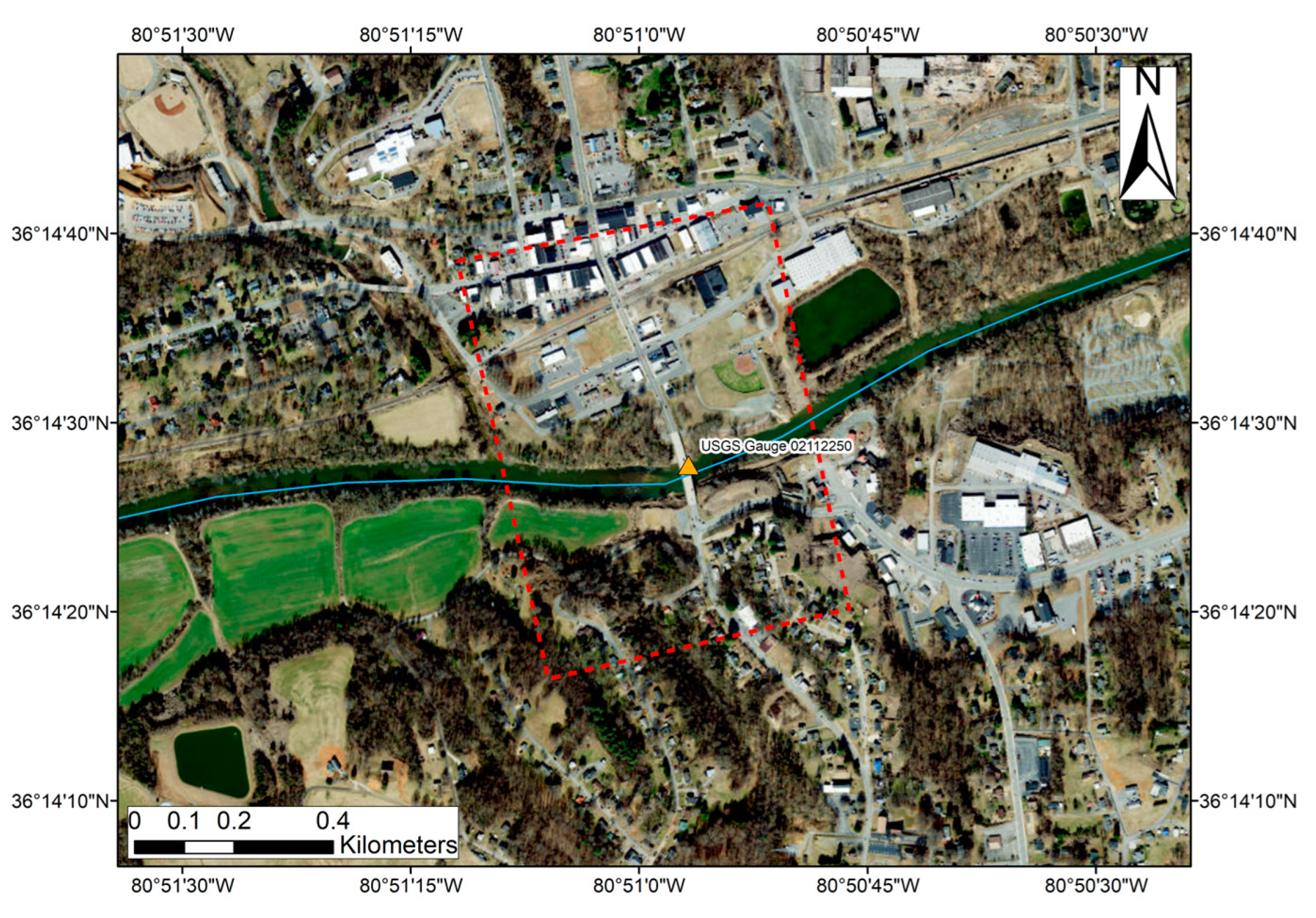


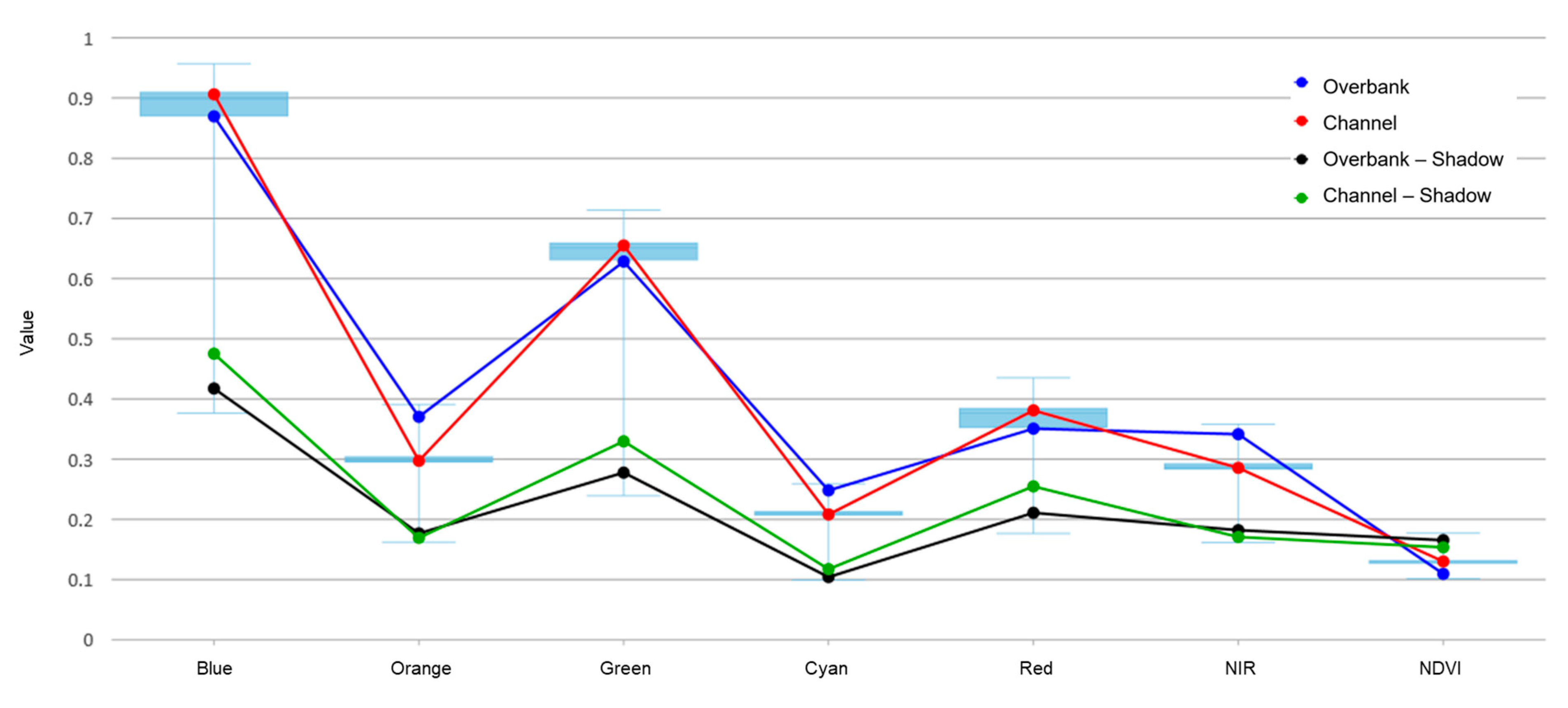
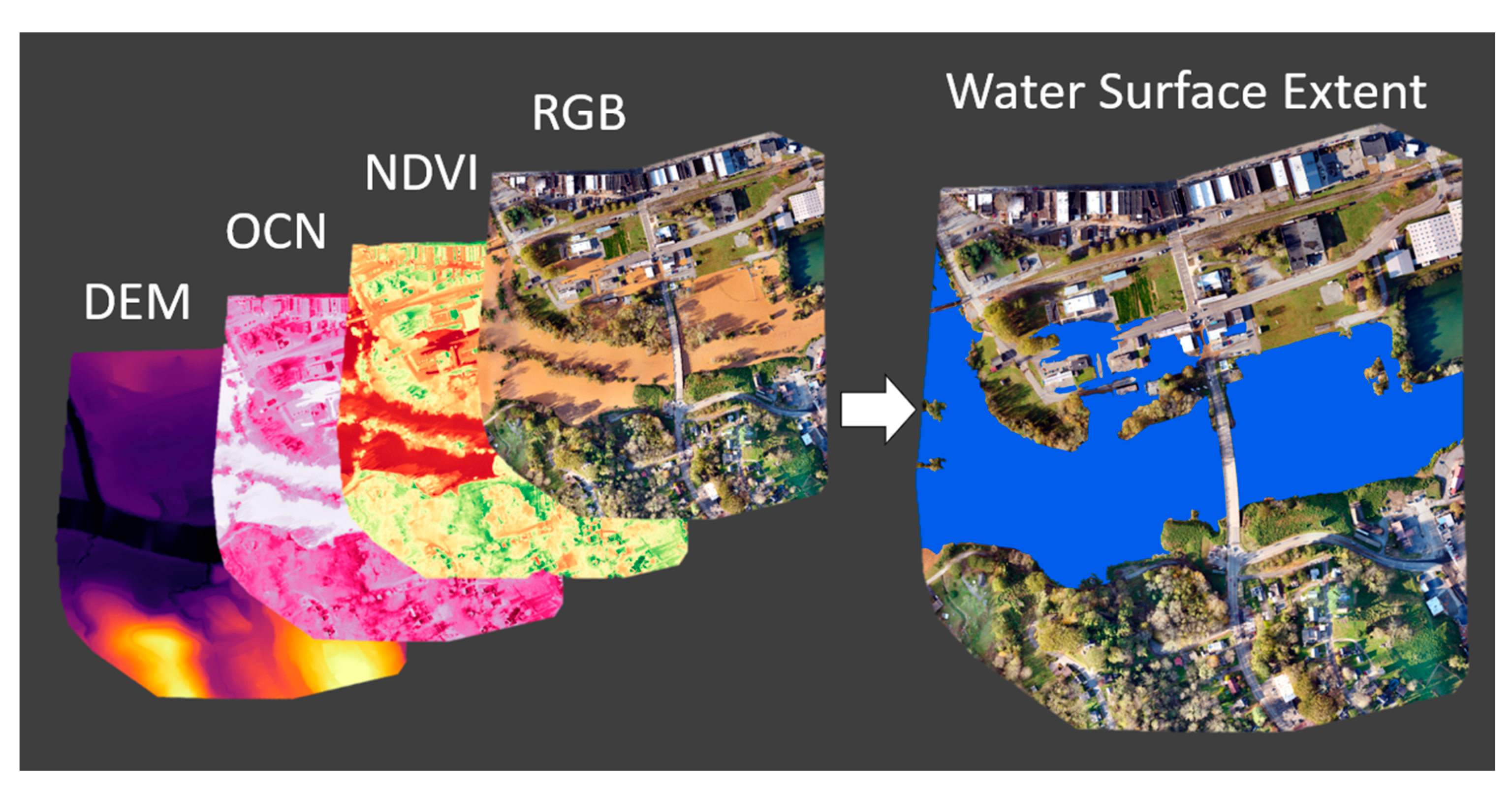
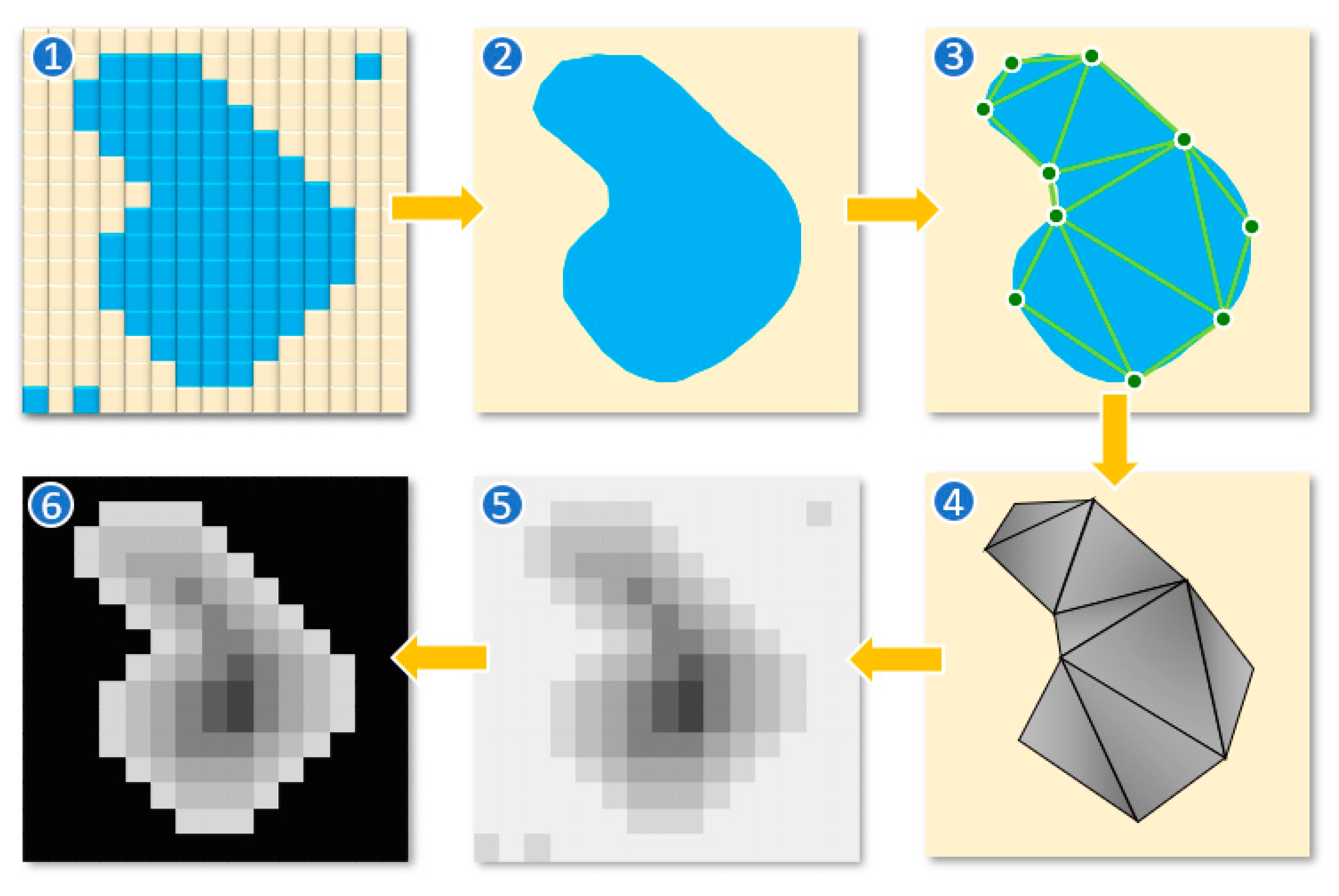


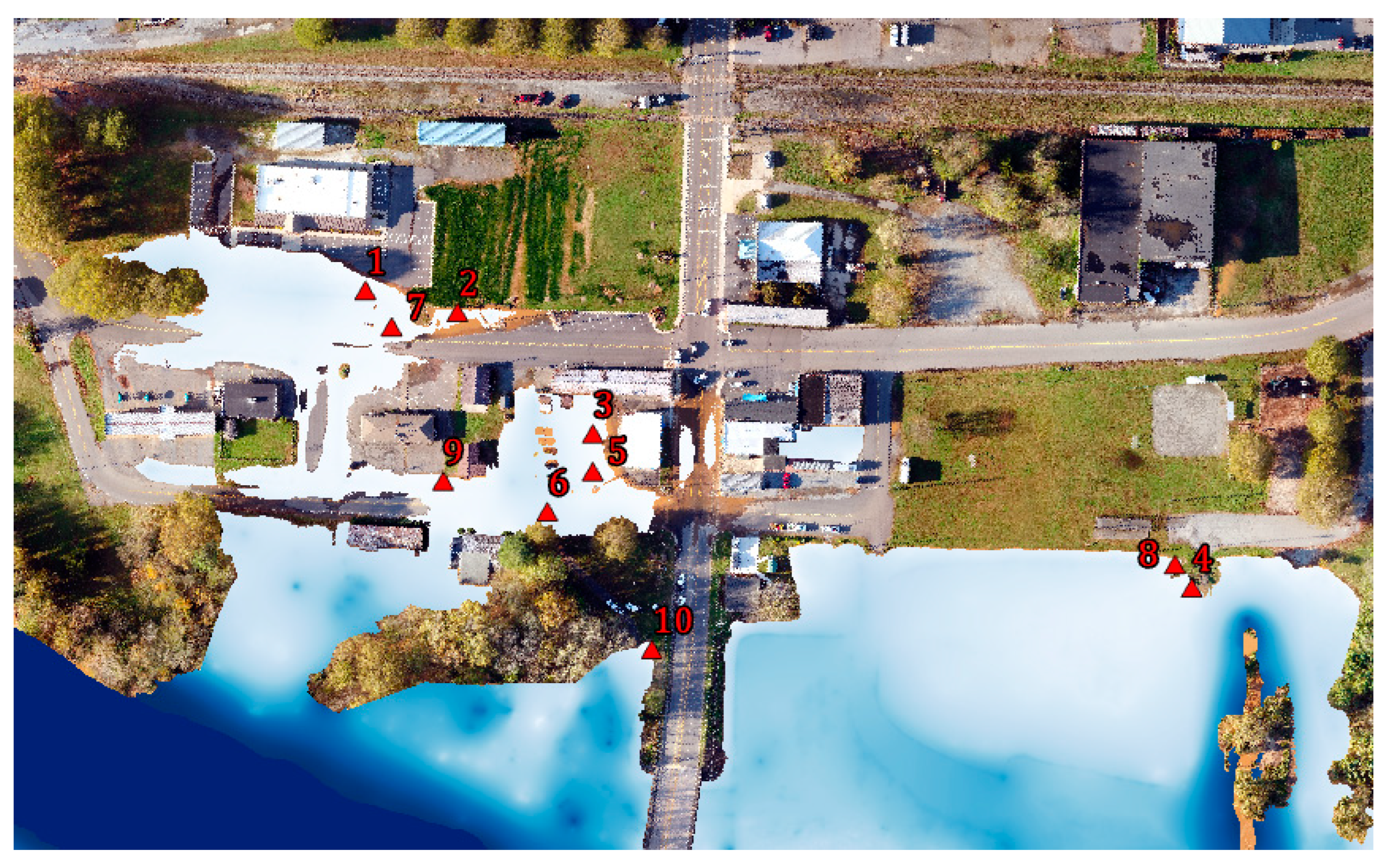

| Band | Name | Extraction Range (DN) | Source |
|---|---|---|---|
| 1 | Blue | 0.38–0.91 | Phantom 4 Pro |
| 2 | Orange | 0.16–0.39 | Mapir Survey 3 |
| 3 | Green | 0.24–0.71 | Phantom 4 Pro |
| 4 | Cyan | 0.10–0.26 | Mapir Survey 3 |
| 5 | Red | 0.18–0.44 | Phantom 4 Pro |
| 6 | NIR | 0.17–0.36 | Mapir Survey 3 |
| 7 | NDVI | 0.00–0.18 | Mapir Survey 3 |
| 8 | DSM | ≤270.72 m | Phantom 4 Pro/RTK GNSS Receiver |
| Model | Resolution (Cm) | Inundation % | Depth Range (m) | Mean Depth (m) |
|---|---|---|---|---|
| FI | 3.3 | 25.6 | 0~9.14 | 2.25 |
| PI | 3.3 | 32.7 | 0~5.76 | 1.25 |
| Model | Accuracy | Commission Error | Omission Error | Total Error |
|---|---|---|---|---|
| FI | 88.83% | 4.59% | 11.17% | 15.77% |
| PI | 87.84% | 15.84% | 22.69% | 38.53% |
| Location | Measured | FI | Diff. (cm) | PI | Diff. (cm) |
|---|---|---|---|---|---|
| 1 | 15.2 | 18.3 | 3.1 | 8.3 | −6.9 |
| 2 | 3.1 | 3.1 | 0.0 | 0.4 | −2.7 |
| 3 | 3.1 | 6.1 | 3.1 | 7.7 | 4.6 |
| 4 | 21.3 | 27.4 | 6.1 | 27.4 | 6.1 |
| 5 | 15.2 | 12.2 | −3.1 | 14.9 | −0.3 |
| 6 | 39.6 | 45.7 | 6.1 | 26.4 | −13.2 |
| 7 | 9.1 | 9.1 | 0.0 | 12.5 | 3.4 |
| 8 | 12.2 | 15.2 | 3.1 | 19.8 | 7.6 |
| 9 | 9.1 | 6.1 | −3.0 | 0 | −9.1 |
| 10 | 12.2 | 15.2 | 3.1 | 70.2 | 58 |
| Average | 14.0 | 15.9 | 1.8 | 18.76 | 4.75 |
| Land Cover | Fully Integrated Model | Partially Integrated Model | |||||
|---|---|---|---|---|---|---|---|
| % Cover | Omission | Commission | Correct | Omission | Commission | Correct | |
| Tree Cover | 12.4 | 34% | 10% | 55% | 35% | 14% | 51% |
| Grassland | 3.6 | 10% | 6% | 84% | 2% | 24% | 74% |
| Built-Up | 44.9 | 17% | 13% | 70% | 5% | 41% | 54% |
| Cropland | 4.3 | 3% | 2% | 95% | 58% | 17% | 25% |
| Bare/Sparse Vegetation | 24.2 | 26% | 14% | 60% | 18% | 36% | 46% |
| Water Bodies | 10.6 | 15% | 7% | 78% | 14% | 6% | 80% |
| Location | Measured | FwDET + UAV-DEM | Diff. | FwDET + LiDAR | Diff. |
|---|---|---|---|---|---|
| 1 | 15.2 | 19.7 | 4.5 | 23.2 | 8.0 |
| 2 | 3.1 | 5.0 | 1.9 | 8.5 | 5.4 |
| 3 | 3.1 | 15.3 | 12.1 | 3.8 | 0.7 |
| 4 | 21.3 | 0.6 | −20.7 | 5.8 | −15.5 |
| 5 | 15.2 | 0.0 | −15.2 | 28.6 | 13.4 |
| 6 | 39.6 | 0.0 | −39.6 | 0.0 | −39.6 |
| 7 | 9.1 | 3.3 | −5.8 | 6.4 | −2.7 |
| 8 | 12.2 | 0.0 | −12.2 | 8.4 | −3.8 |
| 9 | 9.1 | 1.0 | −8.1 | 11.1 | 2.0 |
| 10 | 12.2 | 14.6 | 2.4 | 72.5 | 60.3 |
| Average | 14.0 | 5.9 | −8.1 | 16.8 | 2.8 |
Disclaimer/Publisher’s Note: The statements, opinions and data contained in all publications are solely those of the individual author(s) and contributor(s) and not of MDPI and/or the editor(s). MDPI and/or the editor(s) disclaim responsibility for any injury to people or property resulting from any ideas, methods, instructions or products referred to in the content. |
© 2023 by the authors. Licensee MDPI, Basel, Switzerland. This article is an open access article distributed under the terms and conditions of the Creative Commons Attribution (CC BY) license (https://creativecommons.org/licenses/by/4.0/).
Share and Cite
Wienhold, K.J.; Li, D.; Li, W.; Fang, Z.N. Flood Inundation and Depth Mapping Using Unmanned Aerial Vehicles Combined with High-Resolution Multispectral Imagery. Hydrology 2023, 10, 158. https://doi.org/10.3390/hydrology10080158
Wienhold KJ, Li D, Li W, Fang ZN. Flood Inundation and Depth Mapping Using Unmanned Aerial Vehicles Combined with High-Resolution Multispectral Imagery. Hydrology. 2023; 10(8):158. https://doi.org/10.3390/hydrology10080158
Chicago/Turabian StyleWienhold, Kevin J., Dongfeng Li, Wenzhao Li, and Zheng N. Fang. 2023. "Flood Inundation and Depth Mapping Using Unmanned Aerial Vehicles Combined with High-Resolution Multispectral Imagery" Hydrology 10, no. 8: 158. https://doi.org/10.3390/hydrology10080158
APA StyleWienhold, K. J., Li, D., Li, W., & Fang, Z. N. (2023). Flood Inundation and Depth Mapping Using Unmanned Aerial Vehicles Combined with High-Resolution Multispectral Imagery. Hydrology, 10(8), 158. https://doi.org/10.3390/hydrology10080158









